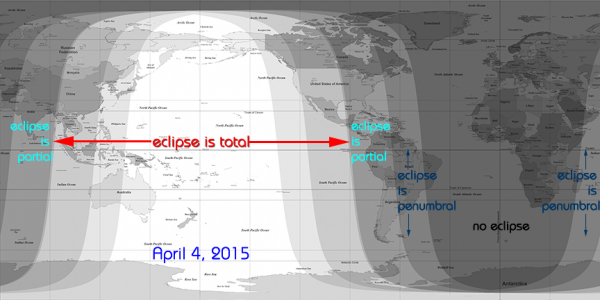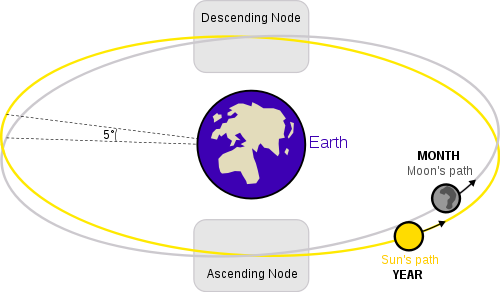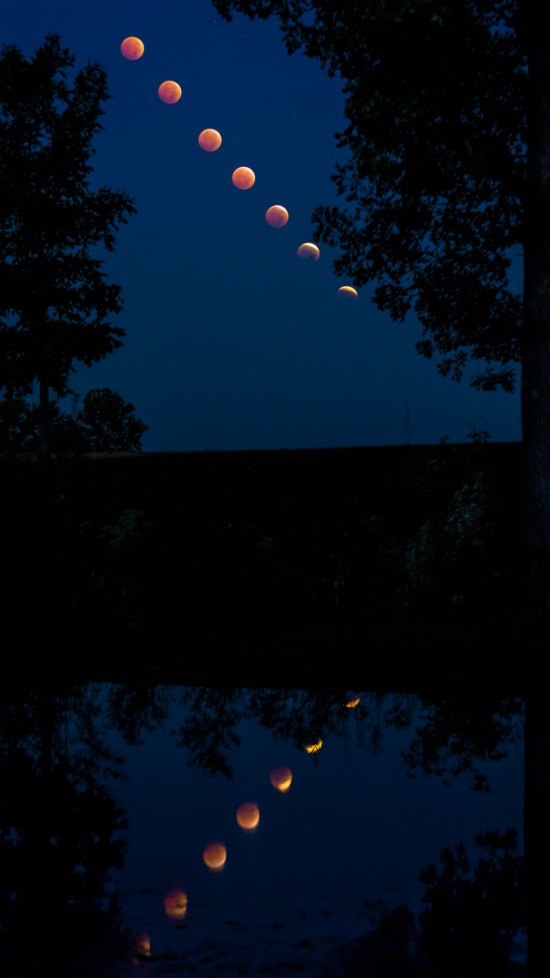
The totality of today’s eclipse has passed. See it! Best photos of April 4, 2015 total eclipse of the moon
The totality – total phase – of the April 4, 2015 lunar eclipse will last less than five minutes, making it the shortest total lunar eclipse of the 21st century. It’s perfect for short attention spans! The whole eclipse including penumbral and partial phases lasts several hours. The total lunar eclipse will be visible from western North America, eastern Asia, the Pacific, Australia and New Zealand. At North American time zones, that means the greatest eclipse happens before sunrise on April 4 – the morning of April 4, not the evening. From the world’s Eastern Hemisphere – eastern Asia, Indonesia, New Zealand and Australia – the greatest eclipse takes place after sunset April 4. Follow the links below to learn eclipse times and more:
Eclipse times in Universal Time
Eclipse times for for North American time zones
Is this the third of four Blood Moon eclipses?
Who will see a partial lunar eclipse?



Eclipse times in Universal Time.
Partial umbral eclipse begins: 10:16 Universal Time (UT)
Total eclipse begins: 11:58 UT
Greatest eclipse: 12:00 UT
Total eclipse ends: 12:03 UT
Partial umbral eclipse ends: 13:45 UT
How do I translate Universal Time to my time?
Eclipse times for for North American time zones.
Eastern Daylight Time (April 4, 2015)
Partial umbral eclipse begins: 6:16 a.m. EDT
Moon sets before start of total eclipse
Central Daylight Time (April 4, 2015)
Partial umbral eclipse begins: 5:16 a.m. CDT
Total eclipse begins: 6:58 a.m. CDT
Greatest eclipse: 7:00 a.m. CDT
Total eclipse ends: 7:03 a.m. CDT
Moon may set before start of total eclipse
Mountain Daylight Time (April 4, 2015)
Partial umbral eclipse begins: 4:16 a.m. MDT
Total eclipse begins: 5:58 a.m. MDT
Greatest eclipse: 6:00 a.m. MDT
Total eclipse ends: 6:03 a.m. MDT
Partial umbral eclipse ends: 7:45 a.m. MDT
Moon sets before end of partial umbral eclipse
Pacific Daylight Time (April 4, 2015)
Partial umbral eclipse begins: 3:16 a.m. PDT
Total eclipse begins: 4:58 a.m. PDT
Greatest eclipse: 5:00 a.m. PDT
Total eclipse ends: 5:03 a.m. PDT
Partial umbral eclipse ends: 6:45 a.m. PDT
Moon may set before end of partial umbral eclipse
Alaskan Daylight Time (April 4, 2015)
Partial umbral eclipse begins: 2:16 a.m. AKDT
Total eclipse begins: 3:58 a.m. AKDT
Greatest eclipse: 4:00 a.m. AKDT
Total eclipse ends: 4:03 a.m. AKDT
Partial umbral eclipse ends: 5:45 a.m. AKDT
Hawaii-Aleutian Standard Time (April 4, 2015)
Partial umbral eclipse begins: 12:16 a.m. HAST
Total eclipse begins: 1:58 a.m. HAST
Greatest eclipse: 2:00 a.m. HAST
Total eclipse ends: 2:03 a.m. HAST
Partial umbral eclipse ends: 3:45 a.m. HAST
Remember … you have to be on the night side of Earth while the lunar eclipse is taking place to witness this great natural phenomenon. Of course, people around the globe want to know whether the eclipse is visible from their part of the world and at what time. To find out the local time of the greatest eclipse in your sky, click on this eclipse calculator and put in the name of a city near you. No time conversion is necessary because the eclipse times are given in local time.
Eclipse computer courtesy of the US Naval Observatory


Is this the third of four Blood Moon eclipses? Depending on the algorithm being used, the April 4 lunar eclipse can be regarded as a very shallow total lunar eclipse or a very deep partial lunar eclipse. The eclipse master, Fred Espenak, assures us that it’s actually a total eclipse of very short duration, despite some sites calling it a partial eclipse. Good thing, or else this April 4 eclipse wouldn’t rate as a so-called Blood Moon. This eclipse counts as the third in a series of four straight total lunar eclipses – a lunar tetrad – all of which are visible from North America!

Who will see a partial lunar eclipse? A partial lunar eclipse precedes the total eclipse for one hour and 42 minutes, and follows totality for one hour and 42 minutes.
So, from start to finish, the moon takes 3 hours and 29 minutes to totally cross Earth’s dark umbral shadow. Eastern North America and western South America can see beginning stages of the partial umbral eclipse low in the west before sunrise April 4, whereas middle Asia (India, western China, mid-Asian Russia) can view the ending stages of the partial umbral eclipse low in the east after sunset April 4. Greenland, Iceland, Europe, Africa and the Middle East won’t be able see this eclipse at all. See worldwide map below.
Incidentally, a very light penumbral eclipse comes before and after the dark (umbral) stage of the lunar eclipse. But this sort of eclipse is so faint that many people won’t even notice it. The penumbral eclipse would be more fun to watch from the moon, where it would be seen as a partial eclipse of the sun.
Worldwide map of the 2015 April 4 total lunar eclipse

Day and night sides of Earth at greatest total eclipse

What causes a lunar eclipse? A lunar eclipse can only happen at full moon. Only then is it possible for the moon to be directly opposite the sun in our sky, and to pass into the Earth’s dark umbral shadow. Most of the time, however, the full moon eludes the Earth’s shadow by swinging to the north of it, or south of it. For instance, the March 2015 full moon swung south of the Earth’s shadow. Next month – in May 2015 – the full moon will swing north of the Earth’s shadow.
The moon’s orbital plane around Earth is actually inclined at 5o to the ecliptic – Earth’s orbital plane around the sun. However, the moon’s orbit intersects the ecliptic at two points called nodes. It’s an ascending node where it crosses the Earth’s orbital plane going from south to north, and a descending node where it crosses the Earth’s orbital plane, going from north to south.
In short, a lunar eclipse happens when the full moon closely coincides with one of its nodes, and a solar eclipse happens when a new moon does likewise. It’s not a perfect alignment this time around, with the moon crossing its ascending node about 9 hours before the moon turns full. But that’s close enough for the moon to stage a total lunar eclipse, even if it happens to be the shortest one of the 21st century!

Bottom line: The eclipse of April 4, 2015 is the third in a series of four total lunar eclipses – a lunar tetrad – all of which will be visible from North America. The nearby blue-white star is Spica. Details of the eclipse, and eclipse times, here.
Need more details? Visit Fred Espenak’s page
EarthSky astronomy kits are perfect for beginners. Order today from the EarthSky store
Donate: Your support means the world to us












